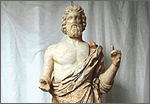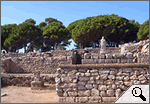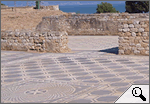|
|
|
 |
 |
 > Esculapi > Empúries: Greek… > …and Roman dimarts, 11 de març de 2008
Esculapi of Empúries is about to return to its original place, almost 100 years after it was discovered. The famous Greek statue will head towards Empúries (Escala, Alt Empordà) this coming Saturday, 15 March, a journey that will mark the beginning of centenary commemorations of the Greco-Roman archaeological site where the statue was found.
Shortly after the discovery, Esculapi (or Asclepi) of Empúries was moved to Barcelona where, until now, it has been exhibited at the Archaeology Museum of Catalonia's main museum there. Two years ago, the museum began a study to research the statue and began restoration work. Now complete, the work has involved restoring both of the statue's arms and putting back 85 fragments that were uncovered during excavation work. After the meticulous restoration work was completed, the statue was put on display at the 'Esculapi: Return of the God' exhibition, shown in Barcelona, Badalona (Barcelonès) and Mataró (Maresme), where the exhibition closes today. As we said above, the arrival of the statue at Empúries marks the beginning of the centenary celebration of the archaeological excavations (begun in 1908) by the architect, art historian and politician Josep Puig Cadafalch, with the full support of the then president of Barcelona Provincial Council, Enric Prat de la Riba. Events to mark the commemorations will be announced the day after tomorrow in Empúries.
Esculapi
+ Esculapi is a 2.15m-high statue of the Greek god of medicine Asclepius.
Found in Empúries in 1909, Esculapi is a 2.15m-high statue of the Greek god of medicine Asclepius. Made of marble, the statue is considered to be the best Classical sculpture from the Western Mediterranean. The research study and restoration work have discovered that the statue is Greek, dating back to the 2nd century BC. It was transported to Empúries by boat, possibly from a workshop on the Greek island of Delos. We also know that it was made from pieces that were made separately using two different types of marble: one for the body, the other for the clothing.
Empúries: Greek…The Greeks' presence in Empúries dates back to 575 BC. The colonisers, who were traders, came from Marseille ('Massalia', in Greek), which was founded around 600 BC by Greeks from Phocaea (Anatolia, present-day Turkey). The Greeks first settled on a small island, where the current town of Sant Martí d'Empúries currently is. Shortly afterwards, they established a new city that grew rapidly as a result of trade with neighbouring Iberian towns. The remains of the city can be found at a beautiful location near the sea. Right in the middle of the archaeological site is the Agora, the public place found in Greek cities.
…and RomanNearby the ruins of the Greek city are those of the Roman city. The Romans landed at Empúries in 218 BC during the Punic Wars fought between Rome and Carthage. A few years later, in 195 BC, an army under the command of Cato the Elder set up camp at Empúries and it became the embryo of the Roman city. During the time of the emperor Augustus, the two cities (the Greek and the Roman ones) were joined under one name, Emporiae. Empúries was, therefore, the entrance to two great Mediterranean civilisations.
|
Investiga

> Noves dades sobre l'Esculapi d'Empúries.

> Vista panoràmica de les restes gregues d'Empúries.

> L'obra arquitectònica de Josep Puig Cadafalch, impulsor de les excavacions d'Empúries.

> L'antiga Grècia, en mapes.
I també...
- Cop d'ull al jaciment romà.
- Article enciclopèdic sobre Asclepi.
- Els déus olímpics, concisament descrits.
- Glossari de l'antiga Grècia.
- D'Empúries estant: fotografia.
Portada |
Europa Press |
El Punt |
La premsa |
Especials |
Diari de l'escola |
LesFinances.info |
Editorials |
Mail obert |
Els blocs |
Lletres
Tecnologia i ciència | Solidaritat | Cap de 7mana | Campus | El 9 | Presència | Fòrums | Enquestes | Xat | Correu
Traductor | Edicions en Pdf | Wap-pda | Biblioteca | Lletra més grossa
Tecnologia i ciència | Solidaritat | Cap de 7mana | Campus | El 9 | Presència | Fòrums | Enquestes | Xat | Correu
Traductor | Edicions en Pdf | Wap-pda | Biblioteca | Lletra més grossa
| Què és VilaWeb? Publicitat Mapa web Contacte | Una web de Partal, Maresma i Associats, S.L. |



